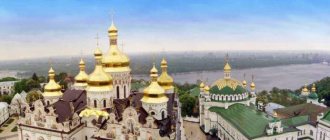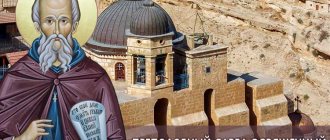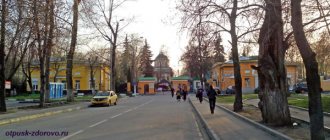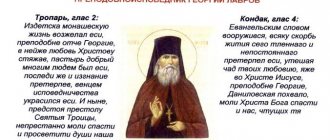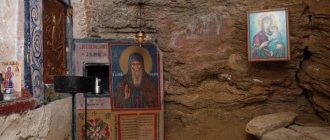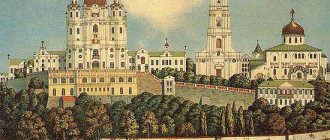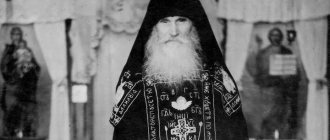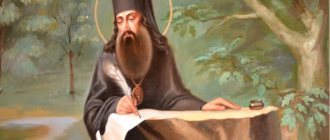| St. Theodosius of Totemsky. Icon (Sergiev Posad, icon painting school, 1990s) |
Theodosius (Sumorin), Totemsky
(c. 1530 - 1568), venerable Memory January 28 on the day of death, September 2 (discovery of relics), March 23 (Greek [1])
Born in Vologda around 1530 and was raised in piety and fear of God. Having reached adulthood, at the insistence of his parents, Theodosius married and had a daughter, but family life did not distract him from his active love for God. He diligently attended church and prayed a lot at home, especially at night. After the death of his parents and wife, having given all his fortune to his relatives to raise his daughter, Theodosius retired to the Vologda Transfiguration Monastery of St. Demetrius of Prilutsky and, having taken monastic vows here, humbly carried out all the difficult monastic obediences: chopping wood, baking bread, grinding flour, doing everything with zeal .
Having gone on behalf of the abbot of the monastery to Totma to look after the monastery saltworks, he cared for the workers and was meek and merciful towards them. His management was such that never before had saltworks brought in as much income as under him. After the inhabitants of Totma began to move to a new place, the monk wished to found a monastery in these places. The population of Totma and the surrounding villages, who knew and loved St. Theodosius even at the Varnitsa, heard about this, came to him and brought everything necessary for life.
In 1554, having received the royal letter of indemnity and, as a blessing from the Prilutsky Monastery, the icon of the Mother of God (now known under the name “Sumorinskaya” [2] miraculous), the Monk Theodosius began to build a monastery and within one year, with the help of neighboring residents, erected a wooden church, meals, cells and other necessary buildings.
Having himself received a good education in his youth, the saint strove for the spiritual enlightenment of his brethren and over time collected an extensive library in the monastery. Through the efforts of the monk, the desolate Ephraim hermitage in the same Totem district was also restored. Being the rector of now two monasteries, the Monk Theodosius was constantly in prayer and labor, setting an example for the brethren. Foreseeing his imminent death, the saint left a spiritual testament, in which, in particular, he persistently emphasized the need for church prayer for all the departed.
Died on January 28, 1568. About 150 posthumous miracles of the saint are known.
On September 2, 1796, during the reconstruction of the temple, the incorruptible relics of the saint were found.
In 1919, the relics, despite the protests of believers, were opened and put on public display. Fearing further worship of the saint, the authorities of Totma sent the shrine to Vologda to the anti-religious museum, where it lay in storage for more than 60 years.
In 1988, the relics were transferred by the museum to the Lazarev Gorbachev Church of Vologda.
On September 12, 1994, the relics were transferred to the Trinity Church in the city of Totma, where they were placed in a shrine.
Since 2001, the saint’s relics have been kept in the Church of the Nativity of Christ in the city of Totma.
On September 15, 2016, the shrine with holy relics was transferred in a procession from the Church of the Nativity of Christ in Totma to the Spaso-Sumorin Monastery, to the place where they were found in 1796. The relics were placed in the Ascension Cathedral, which was being restored [3].
| St. Theodosius of Totemsky. Icon (Russian North, 18th century). State Historical Museum |
Prayers
Troparion, tone 1
From your youth, Reverend Theodosius, / you entrusted your desire to Christ God, / for whose sake you left the city and fatherland / and vain glory, as if you counted the dust, / you followed the teacher Bnom Demetrius/ and you were a cohabitant with his monastery,/ moving to the city of Totma/ and you dwelt in the midst of the conflict,/ with fasting and vigil, and shaggy clothing,/ and with chains you afflicted your body./ For this reason, God, seeing your labors,/ after your repose, enriched you with miracles :/ you drive out demons and enlighten the blind,/ from all sorts of ailments and you deliver from troubles/ coming to you with faith and crying out:/ glory to Him who gave you strength, glory to Him who crowned you,// glory to Him who gives you healing to all.
Troparion, voice 2
From worldly rebellion I came out, / like our Father Theodosius, / and reached a quiet refuge, / you were a roommate with the Monk Demetrius, / and from there, by the Spirit of God, we are guided, / to the city You dwelt in darkness,/ and in your father you built abodes of water for yourself, / having lived an equal life with the angels, / you followed Christ, / for whose sake you wore the hair robe and chains on your body. / Adorned with humility and love of poverty, / with vain glory you despised / and you squandered your father’s property well, / with prayer to God and tears You have put the demons to shame with streams, / Moreover, after your dormition, Christ has enriched you with the gift of miracles. / Having now boldness in the Lord, / like our Father Theodosius, / pray to Christ for Yeah, may he save our souls.
Kontakion, tone 8
(similar to: Taken:)
With abstinence you exhausted your flesh/ and with unceasing prayers, like an Angel, you exalted yourself,/ with streams of tears you immersed the demonic armies./ And now in the unevening Light you rejoice with Christ God/ and to those who come to your holy tomb you generously give healing,/ to those who cry out to you by faith: // Rejoice, Father Theodosius the God-Wise.
Venerable Theodosius of Totem
The chapel on the ground floor of the new Church of the Triumph of Orthodoxy was consecrated in honor of St. Theodosius of Totem.
Life of St. Theodosius of Totemsky
Memory - February 10 (January 28, old style);
September 15 (September 2, old style) – discovery of relics.
In the world
The Monk Theodosius of Totem was one of the most revered saints in the former Vologda diocese. His fame as a miracle worker went beyond the Vologda borders.
He was born around 1530 in the city of Vologda into a pious family of noblemen, the Sumorins. Raised by his parents in the fear of God, Theodosius from childhood was distinguished by a God-loving mood.
At the request of his parents, he married and had a daughter, Marina. But his family life was short-lived. After the death of his parents and wife, Theodosius, having given all his fortune to his relatives to raise his daughter, entered the Spaso-Preobrazhensky Monastery of St. Demetrius of Prilutsky, located near Vologda (photo 1 - Prilutsky Monastery).
On the monastic path
Seeing the piety of the new monk, the abbot tonsured him as a monk without the usual probationary period in such cases and entrusted him to an experienced elder.
Theodosius fulfilled all the obediences assigned to him with joy and zeal, trying to serve each of the brethren. At the same time, he did not miss a single service and was the first to come to the temple.
On behalf of the abbot, the monk was sent to the city of Totma to supervise the monastery saltworks. He cared for the workers, was meek and merciful with them. Never before have saltworks generated so much income.
Birth of a new monastery
Seeing that there were many zealots of monasticism among the local residents, Theodosius decided to establish a monastery here. On a high cape, between two rivers flowing into the Sukhona, he found a convenient picturesque place, surrounded by wooded mountains.
This land belonged to the Posad widow Marya Istomina, and the elder asked her: “Let him be given a place to create a church and a monastery to host a meeting of monks,” to which she agreed.
Having taken the blessing of the abbot of the Prilutsky monastery for the construction of a new monastery, the Monk Theodosius erected a cross here and from 1553 began to asceticize first in a hut, then in a dugout, and then built a wooden cell with his own hands.
The inhabitants of Totma joyfully received the news of the monk’s intention to found a monastery in these places. They began to bring him everything he needed to live, and many made large donations.
Such zeal of the population prompted the elder to go with a petition to Moscow to Tsar Ivan Vasilyevich the Terrible. On February 20, 1554, he received the blessing of Metropolitan Macarius and the sovereign’s permission to create a monastery and a royal charter, which freed the newly built monastery from all taxes.
On the way back, the monk went to the Prilutsky Monastery to pray at the holy relics of its founder and received from the abbot an icon of the Mother of God, which later became known as the Sumorinskaya miraculous one (photo 2 - Sumorinsky image of the Mother of God). After the death of the saint, the icon was in the Ascension Church of the monastery.
Growth and prosperity of the Totem monastery
The construction of the monastery began with the construction of a wooden church in the name of the Transfiguration of the Lord; later monastic cells and other necessary buildings were erected. And in 1555, Theodosius was issued another royal charter, which allowed him to build his own salt pipe at the Totemsky saltworks and sell the mined salt for the benefit of the monastery duty-free.
The tireless builder and abbot (photo 3 - St. Theodosius of Totemsky) managed to create an exemplary and well-coordinated monastic economy, which contributed to the prosperity of the Totemsky monastery and its transformation into the center of Orthodox spirituality.
The skillful management and amazing diligence of the saint allowed Archbishop Nikander of Rostov to entrust him in 1560 with the construction of the desolate Spaso-Nicholas Ephraim Hermitage, located in the Totemsky district. The monk restored this monastery and established a brotherhood in it.
Caring for the spiritual life of monks
Thanks to the cares of the saint, who strived for the spiritual enlightenment of the brethren, the monastery was enriched with an extensive library, which contained not only liturgical books, but also the theological works of St. John Chrysostom, St. Ephraim the Syrian and other teachers of the Church, which were dear at that time.
According to the rules determined by the Monk Theodosius, the monks of his monastery were to eat from the labors of their hands, give alms and remain in unceasing prayer. Continuous reading of the Psalter about the departed was also established.
For the deep humility of the abbot, who attributed everything to the help of God and never to himself, the Lord granted him success in all his affairs and endeavors.
Being the rector of two monasteries, the Monk Theodosius was constantly in prayer and labor, setting an example for the brethren to follow.
For thirteen years the monk was abbot of the Transfiguration Monastery. On January 1 (December 19, old style) 1567, foreseeing his imminent death, Saint Theodosius (photo 4 - St. Theodosius in the schema) dictated a spiritual testament, in which, in particular, he persistently emphasized the need for church prayer for all the deceased, no matter how righteous they were nor did they seem during life.
Demise
The saint's earthly journey ended on January 28, 1568. Having blessed and fatherly kissed each of his spiritual children, he quietly fell asleep in eternal sleep. After his death, the amazed brethren discovered that he wore a hair shirt and chains that cut into his body. During the life of the monk, they did not suspect this, since no one ever saw a shadow of fatigue or suffering on his face.
He was buried near the altar of the wooden Transfiguration Cathedral he built.
Miracles
Forty years after the death of St. Theodosius, the first healings took place at his grave. Of his posthumous miracles, 146 are recorded. Here is a story about two of them.
*
One woman brought her blind daughter Justina to the monastery and asked permission to spend the night in the locked church near the tomb of the monk. At night she saw two monks heading towards the church. One of them says: “I bring holy water to wash the eyes of blind Justina.” Then everything disappeared, but Justina felt that her eyes were being washed and holy water was being sprinkled all over her, and she also heard singing. In the morning it turned out that she had received her sight.
*
A certain Firsov went on a business trip to Moscow; There he fell ill, his face was covered with ulcers. He thought about Saint Theodosius and regretted that he could not pray at his tomb. At night, he saw in a dream that the monk was leading him to his mother’s house in Totma and telling her: “Receive your son healed.” When he woke up, he felt that his strength had been restored, and his face was completely clean.
Posthumous veneration
The first icon of the saint appeared in 1612. It was written by the Totem icon painter Yakov Popov, based on the stories of a hundred-year-old man who knew the saint. Since 1626, icons of the saint became widespread.
In 1655, the church in which the monk rested was burned, but his wooden tomb survived.
Emperor Peter I, during his trip to Arkhangelsk, visited the Spaso - Sumorin Monastery on July 17, 1693 and laid an amber Crucifix on the icon of the saint of God Theodosius. In 1729, a service to the saint was compiled; it was served not only in the monastery, but also in the churches of Totma and the surrounding area, although the saint had not yet been canonized.
Finding relics. Praise
Over time, the veneration of St. Theodosius was forgotten. In 1764, under Empress Catherine II, a Decree on regular and supernumerary monasteries was issued, according to which more than half of all monasteries in Rus' were closed. The Spaso-Sumorin Monastery was also included in the state.
The monastery began to decline. Although the churches in the monastery were stone and recently built, the Church of the Ascension was in a deplorable state, and it was proposed to dismantle it.
On September 2, 1796, during the reconstruction of the Church of the Ascension, incorruptible relics were discovered. According to the words embroidered on the schema, it was revealed that in the coffin lay the body of the Monk Theodosius Sumorin, the founder and head of the monastery. The body of the ascetic lay in the ground for 228 years. But when the coffin was opened, an extraordinary fragrance spread around.
On January 28, 1798, after a three-time examination of the relics, the canonization of the saint of God took place.
(Photo 5 - Totma. Spaso-Sumorin Monastery. Photo from the beginning of the 20th century)
Return of the shrine to Totma
In 1919, the relics of Theodosius of Totemsky, despite the protests of believers, were opened and put on public display. Fearing further worship of the saint, the authorities of Totma sent the uncovered relics to Vologda to the anti-religious museum, where they lay in storage for more than 60 years.
In 1988, in honor of the 1000th anniversary of the Baptism of Rus', the relics were transferred by the museum to the Lazarev Gorbachev Church of Vologda. On September 12, 1994, the solemn transfer of the relics took place to the Trinity Church in the city of Totma, where they were placed in a shrine. Since 2001, the relics have been in the Nativity Church of Totma (photo 6 - Cancer with the relics of St. Theodosius).
The ensemble of the monastery has reached us only partially. Among the surviving buildings are the Ascension Cathedral (1796–1801), the Spaso-Preobrazhensky Cathedral (1689, rebuilt beyond recognition at the end of the 19th century), a two-story abbot's building, a fraternal building, a hotel for pilgrims, as well as part of the wall with towers and the entrance gate, all XIX century. Currently, the Spaso-Sumorin Monastery has begun to be restored.
Troparion, tone 1
From your youth, Reverend Theodosius, / you entrusted your desire to Christ God, / for whose sake you left the city and fatherland / and vain glory, imputing dust as dust, / you followed the Reverend Demetrius / and you were a cohabitant of his monastery, / moving to the city of Totma / and you settled in between the rivers, / with fasting and vigil, and a hair-cloth robe, / and you afflicted your body with chains. / For this reason, God, having seen your labors, / after your repose, enriched you with miracles: / casting out demons and enlightening the blind, / delivering from all illnesses and troubles those who come to you with faith and cry out: / glory to Him who gave you strength, / glory to Him who crowned you, / glory to Him who gives healing to everyone through you.
Kontakion, tone 8
With abstinence you have exhausted the flesh/ and with unceasing prayers, like an Angel, you have exalted yourself,/ with streams of tears you have immersed the demonic shelves./ And now in the unevening Light you rejoice in Christ God/ and to those who come to your holy tomb you have generously given healing,/ by faith to those who cry out to you: / Rejoice, Father Theodosius the Wise God.
Prayer
O our good shepherd and God-wise mentor, Rev. Father Theodosius!
Hear us, sinners, praying to you and calling for your quick intercession to help, see us, sinners, in the face of existing circumstances, see us, weak, caught from everywhere, deprived of every good and darkened in mind from cowardice, strive, servant of God, do not leave us to be in sinful captivity, may we not joyfully be our enemy and may we not die in our evil deeds.
Pray for us, unworthy, of the Lord the Savior; you stand before Him with disembodied faces. Make our Creator merciful to us in the present world and in the future, may He not reward us according to our deeds and the impurity of our hearts, but may He reward us according to His goodness, for we trust in your intercession, we boast of your intercession, we call upon your intercession for help and , to the healing power of yours, falling, unworthy, we ask for healing:
deliver us, saints of Christ, from the evil ones who come upon us, and tame the waves of passions and troubles that rise upon us, so that for the sake of your holy prayers the attack will not overwhelm us and we will not wallow in the abyss of sin and in the mud of our passions.
Pray, Reverend Father Theodosius, to Christ our God, that he may grant us a peaceful life, forgiveness of sins, salvation for our souls and great mercy. Amen.
___________
When compiling this article, materials from the following sites were used:
Used materials
- “Reverend Theodosius of Totemsky”, calendar page on the portal Pravoslavie.Ru
: - Menaion-January, part 2, ed. Moscow Patriarchate, p. 453, 461:
- - troparia
- files2.regentjob.ru/minea/jan2/jan2461.html - kontakion
[1] “Ὁ Ὅσιος Θεοδόσιος ὁ Θαυματουργός ἐκ Ρωσίας”, page of the Greek site ΜΕΓΑΣ ΣΥΝΑΞΑΡΙΣΤΗ Σ (Great month)
, according to the book: Αγαθάγγελος (Χαραμαντίδης), Επ.
Φαναρίου, ΜΕΓΑΣ ΣΥΝΑΞΑΡΙΣΤΗΣ
(Bishop of Phanaria Agathangel, “Synaxarion of the Orthodox Church”), Αποστολικής Διακονίας τη ς Εκκλησίας της Ελλάδος, .
[2] by the surname of the Reverend - Sumorin.
[3] “The relics of the founder of the monastery, St. Theodosius of Totemsky, were returned to the Spaso-Sumorin Monastery” -
